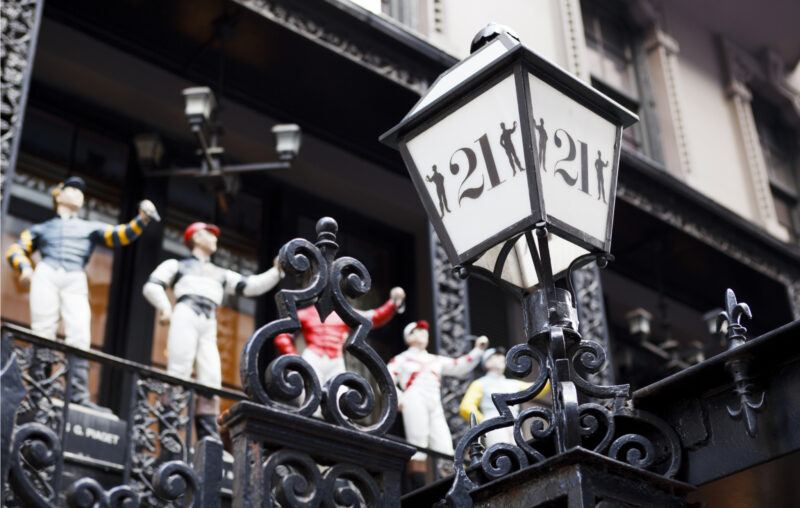Will 21 Club’s Demise Finally Awaken People To New York City’s Slow Suffocation?

I first learned about 21 Club through television. It was on the classic CBS series The Jeffersons.
The exact episode escapes me, but Lionel, the son of an increasingly successful George Jefferson, was doing well enough at his job that he would soon be taking wife Jenny to dinner at 21. George was informed of this happy turn of events only to reach into his pocket to pull out a wad of cash that he pressed into his son’s hand. He instructed Lionel to take Jenny to “22.”
For decades 21 Club represented aspiration in the world’s most aspirational city. If New York City has long been the “final test” for the talented as writer Ken Auletta observed decades ago, 21 Club has been the restaurant where those who passed celebrated the achievement.
Sadly, the now shuttered 21 will soon no longer be. It was announced recently that the inimitable Manhattan institution will close for good in March of 2021. Its 148 extraordinarily dedicated employees will be terminated with the restaurant’s closure. So sad. And so typical.
The coronavirus has always been a rich man’s scare, and yet again those with the least will suffer the nail-biting of those who will never miss a meal. The hysteria about the virus has always had a regressive quality to it whereby those who had the temerity to start March of 2020 with a job that was – gasp – a destination would suffer the jangled nerves of those for whom work is increasingly an anywhere thing.
In particular, politicians who’ve long forgotten what it’s like to count the days until the next paycheck (think Andrew Cuomo and Bill de Blasio, among others) have for all this time been making choices for those who do. Their implicit message has been that those who go somewhere for work, and who can’t get paid unless they’re helping people in person, can mostly drop dead.
About this, let’s please not respond with the nonsense about restaurants being spreader locales. If we ignore what’s been known for quite some time, that the virus is generally most threatening to those in nursing-home condition, or those in similar condition who live outside one, we can’t ignore that grocery stores and other retail concepts have been open for months without any breakouts. Goodness, even Disney’s parks have been open for several months, but with no resulting virus spread.
And for those who say businesses were going to shutter no matter what given fear among the citizenry that predated political panic, they might explain record earnings for Target and other businesses that were “allowed” to stay open. They figured out ways to thrive despite limiting capacity at times on their own, and despite the worries of their customers. Furthermore, if it’s true that restaurants had no chance given worry among patrons, why is it that restaurants have been fighting with politicians across the U.S. for months for the “right” to operate?
Let’s please also not respond that New York City restaurants were given the option to host patrons outside, and to a limited degree inside. Anyone who knows New York understands that it’s more than uncomfortable in the summertime, and similarly difficult in the winter. Such a response ignores that particularly on an island as expensive as Manhattan, packed outdoor dining or 25% capacity indoors does not pay the bills. If it did, the size of NYC restaurants would be a great deal smaller.
25% is so typical of a political class that has no concept of how businesses are truly run. To the politicians who seek remuneration and eventual wealth the easy way (by moving around the wealth created by others….of course), actual businesses have always had a foreign quality to them. Political types have just assumed profits were a given. This presumably explains 25% capacity rules. Politicians used to taking a piece of the effort of others, and who’ve done so on the way to comfortable lives, presumably just assume that’s what NYC restaurants can do too. No, restaurant space is expensive. Nosebleed expensive in New York. Businesses don’t last that can only operate at 25% capacity.
Such a childish view also ignores that 21 Club is sui generis. It’s not just that it has remarkable indoor dining spaces, beautiful food, an amazing wine list, and some of the world’s best French fries! 21 also can claim floor after stately floor of private rooms where, during normal times free of restrictions, patrons of various stripes celebrated deals, advocated policies, or just drank and ate with those of similar tastes and goals. Sorry, but 25% of this big property wasn’t going to work. And no, outdoor dining or the restaurant wrapping its genius in plastic for takeout wasn’t going to make up for the kind of business this Manhattan symbol used to do. If the answer is yet again that “the people” had turned tail on NYC restaurants out of fear of the virus, then why the need for forced limits as is?
Indeed, if it’s true that free people were self-selecting out of restaurant dining, it’s a reminder that free people don’t need a law. If they’re at risk they can avoid restaurants, grocery stores, bars, or any other places that they feel imperil their existence. Even better, people are particularly choosy when their actions could potentially sicken them, or in the rarest of instances kill them. They don’t need to be forced to protect themselves, and they certainly don’t need de Blasio or Cuomo to watch over them.
The problem was that New York’s governor and the mayor of the world’s greatest city decided they would do the thinking of the world’s most talented people, and also the protecting. Their arrogance was and is astonishing.
They’ll claim that their actions were all about protecting the hospitals from overflow, but even if true, is protecting NYC’s hospitals worth suffocating what has long made it the world’s greatest, most exciting city? Seriously, did the city’s hospitals make New York the world’s premiere city, or are the great hospitals a consequence of New York City long existing as a magnet for the world’s most creative, ambitious people? We’ll soon know the answer to the previous question, and the bet here is that hospitals won’t be as alluring as the restaurants, bars, entertainment and crowded life that once made NYC great, and that was a magnet for the best and brightest eager to test themselves on the world’s greatest stage.
Reprinted from Forbes










